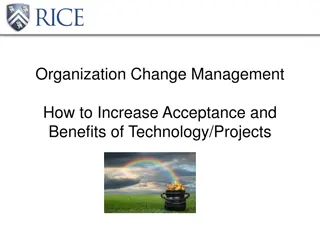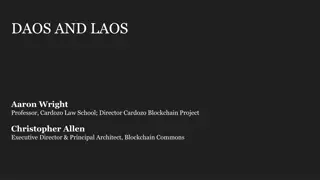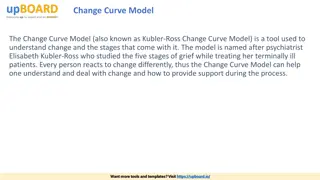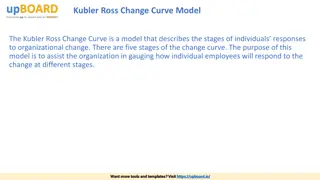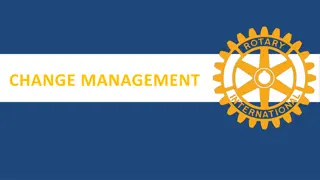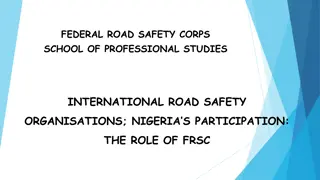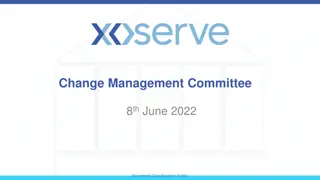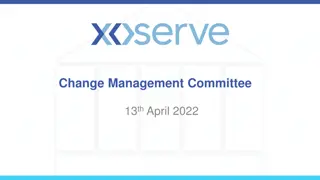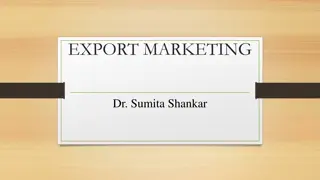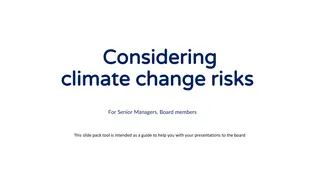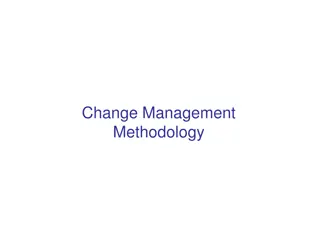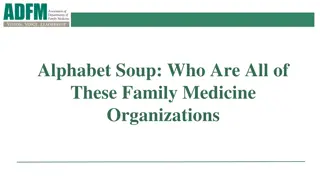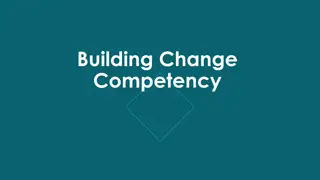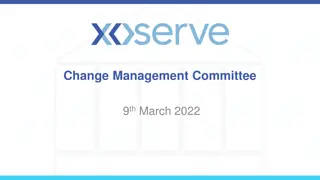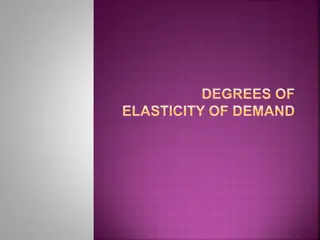Change Management in Organizations
Exploring the importance of change management in organizations, this content dives into key reasons for organized approaches, challenges faced, and strategies for leading successful transformations. From handling resistance to implementing communication strategies, it covers essential aspects for effective change leadership.
Download Presentation

Please find below an Image/Link to download the presentation.
The content on the website is provided AS IS for your information and personal use only. It may not be sold, licensed, or shared on other websites without obtaining consent from the author.If you encounter any issues during the download, it is possible that the publisher has removed the file from their server.
You are allowed to download the files provided on this website for personal or commercial use, subject to the condition that they are used lawfully. All files are the property of their respective owners.
The content on the website is provided AS IS for your information and personal use only. It may not be sold, licensed, or shared on other websites without obtaining consent from the author.
E N D
Presentation Transcript
Leading Change September 2018
Learning Objectives w : Key reasons for having an organized approach to change management that focuses on the people element of change How people adapt to change, why they resist it, and how to respond to resistance An organized, sequential approach to change management How applying the UMMS Competencies is critical to your role in leading change management The central role communication plays in successful change efforts A checklist to monitor and evaluate your progress
Why is Change Management Important? 70% of organizational change initiatives fail. Leading Change Successfully 2nd Edition, Harvard Business Review OnPoint Collection, Feb 1, 2005
Major Change Challenges The most significant challenges when implementing change projects are people-oriented. Changing mindsets and attitudes = 58% Corporate culture = 49% Complexity is underestimated = 35% *Adapted from IBM, Making Change Work , page 14.
Exercise #1 - Approach to Change Think of an example of when you, as a manager, had to support a significant work change (e.g., process, roles, staffing) Your thoughts: Questions: As a manager, what role did you take on to lead the change and help your staff adapt? How was the change communicated? Did you face resistance? If so, why? How did you deal with resistance? What did you learn? What w w ?
There Are Two Sides of Change Any transformation will affect both the organization and its people. Change Management activities are directed toward the people dimension of change. People Dimension of Change Structural Dimension of Change Communication Training Strategy and Operations Business Processes Engagement Technology Organizational Structures
The Goal of Change Management A comprehensive Change Management strategy prepares and engages affected colleagues and stakeholders for new or modified organizations, processes, policies, and technologies. Proactive change management increases engagement, minimizes organizational disruption and productivity losses, and prepares the organization for long-term, sustainable results.
Focus of Change Management - Individual Commitment to Change Ownership! Adoption: Individuals champion the change, taking accountability and ownership for the success of the transformation. Level of Commitment Acceptance: Individuals have a positive attitude regarding the change the new state. They begin to feel accountable for making it happen. Understanding: Individuals can explain the impact of the change on themselves and on the organization. Awareness: Individuals become aware of the change and a vision of the future is introduced. Time
Exercise #2 - Reacting to Change Think about a change that you have experienced at work and answer the questions below. Question: What was the change? How far did you progress in accepting the change? What helped you to accept the change? Was the long-term effect of the change positive or negative? Answer:
Employees adapt to change at different rates Everitt M. Rogers, Diffusion of Innovations (1983).
Reasons for Resistance C -initiated Routine is disrupted - T w Fear of the unknown Purpose of the change is unclear Fear of failure T w Respect for the leaders of the change Personal loss Additional work commitment John C. Maxwell (2001)
Dealing with Resistance ! Bring it out into the open. Identify the assumptions, fears, feelingsbehind it. Take a learning/exploratory stance towards it. Ask questions! Reinforce the necessity of change and help people get there!
Options for Addressing Resistance Drawbacks Can be very time consuming if lots of people are involved. Advantages Once persuaded, people will often help with the implementation of the change. Approach Education & Communication Commonly used in situations Where there is a lack of information or inaccurate information and analysis Commonly used in situations Where the initiators do not have all the information, they need to design the change, and where others have considerable power to resist. Drawbacks Can be very time consuming if participators design an inappropriate change. Advantages People who participate will be committed to implementing the change, and any relevant information they have will be integrated into the change plan. Approach Participation & Involvement Drawbacks Can be very time consuming, expensive, and still fail. Advantages No other approach works as well with adjustment problems. Approach Facilitation & Support Commonly used in situations Where other people are resisting because of adjustment problems. Commonly used in situations Where someone or some group will clearly lose out in a change, and where that group has considerable power to resist. Drawbacks Can be too expensive in many cases if it alerts others to negotiate for compliance. Approach Negotiation & Agreement Advantages Sometimes it is a relatively easy way to avoid major resistance. Drawbacks Can be risky if it leaves people mad at the initiators. Advantages It is speedy and can overcome any kind of resistance. Approach Explicit & Implicit Coercion Commonly used in situations Where speed is essential, and the change initiators possess considerable power.
Change Management Approach Change management is more than communication and training. Engaging others in the change involves leadership alignment and stakeholder readiness. Leadership Alignment Setting and committing to shared goals Stakeholder Readiness Preparing stakeholders for the impacts of change Analysis of stakeholder roles and involvement in project success Planned engagement of leaders to ensure commitment to change and clear understanding of vision of the future Coaching to ensure leaders are appropriately equipped to lead their colleagues through change Strategic engagement of internal and external stakeholders to ensure understanding and commitment to change Communication Training Communicating key messages and gathering feedback Building knowledge and skills to ensure a smooth transition Deliberate, timed and sequenced communication to stakeholders Assessment of stakeholder training needs related to a change Two-way communications to inform and encourage commitment to change Strategic delivery of training courses to equip employees w w , , w
Change Management Sequence 2 1 3 The Details Identify the Change Type of change Reason for change Scope Current state The Approach Stakeholder analysis Resistance to change Role of change management team Process changes People changes Behavior changes Information changes 5 4 Monitor Implement Action plan Communication plan Training plan Resistance plan KPI reporting Sensing behavior Management review
K 8 C Step 1: Establish sense of urgency Unfreeze the organization by creating a compelling reason for why change is needed. Step 2: Create the guide coalition Create a cross-function, cross-level group of people with enough power to lead the change. Step 3: Develop a vision and strategy Create vision and strategic plan to guide the change process. Step 4:Communicate the change vision Create and implement a communication strategy that consistently communicates the new vision and strategic plan. Step 5: Empowered broad-based action Eliminate barriers to change and use target elements of change to transform the organization. Encourage risk taking and creative problem solving. Step 6: Generate short-term wins Plan for and create short- w . R z w w to the wins. Step 7: Consolidate gains and produce more change The guide coalition uses credibility from short-term wins to create more change Step 8: Anchor new approaches in the culture Reinforce the change by highlighting connections between new behavior and process and organizational success.
Your Role in Leading Change Building relationships Working on trust Showing the way Coaching vs. controlling Setting the example Being visionary, inspiring, enthusiastic and focused
UMMS Competencies for Managers Critical for leading change management Sets clear priorities, goals and expectations and provides timely, constructive, and balanced feedback in holding staff members accountable Delegates effectively and empowers team members and flexes style when faced with diverse teams understanding and effectively managing complex group dynamics and diverse perspectives Manages performance problems and team conflicts skillfully Demonstrates effective mentoring, developing and motivating skills Inspires and fosters team commitment, spirit, pride and trust and is attentive to the well-being of her/his staff Takes a long-term view building a shared vision with staff in planning, decision making, and process improvement Acts as a positive role model Ensures that diverse, talented employees are appropriately recruited, selected, oriented, and acclimated to the organization
Exercise #3 - Applying the UMMS Competencies for Managers Provide an example of when you may have demonstrated one or more of the UMMS leadership and management competency elements to help lead a change at work. Your Action: Competency Element:
Communicate, Communicate, Communicate! Use every vehicle/forum formal and informal Establish a communication plan Lead by example Establish two-way communication Keep focus positive Keep message simple Explain seeming inconsistencies Encourage differences of opinion Key Associates, 2008
9 Tactics for Communicating I Stories. When you tell a good story, you give life to a vision. The telling of stories creates trust, captures hearts and minds, and serves as a reminder of the vision. Plus, people find it easier to repeat a story than talk about a vision statement. The elevator speech. Every leader needs to be able to communicate the vision in a clear, brief way. What compelling vision can you describe in the amount of time you have during a typical elevator ride? Be prepared to reinforce the vision in line at the cafeteria, when you visit other departments, and even walking through the parking lot at the end of the day. Multiple media. The more channels of communication you use, the better your chance of creating an organization that "gets" the vision. Use meetings, memos, lunches, podcasts, e-mail, an internal web site, and whatever else you can think of (Twitter, anyone?) that will keep the message in circulation. Talk to me. Individualize the vision by engaging others in one-on-one conversations. Personal connections give leaders opportunities to transmit information, receive feedback, build support and create energy around the vision. Center for Creative Leadership, February 2009
9 Tactics for Communicating II Draw a crowd. Identify key players, communicators, stakeholders and supporters throughout the organization who will motivate others to reflect on and be engaged with the vision. Go outside. Communicate to external customers, partners and vendors with advertising and public relations campaigns, catalogs, announcements and other statements. Make memories. Create metaphors, figures of speech and slogans and find creative ways to use them. Write a theme song or a memorable motto. Guide the expedition. Use visual aids and updates to keep everyone aware of the progress you are making toward your vision. Create a vision GPS, but don t just give out maps. Travel alongside, stay out in front, offer directions and point out guideposts. Back it up. If you re talking it up, be sure to back it up with actions and behaviors. If people see one thing and hear another, your credibility is shot and your vision is dead. Center for Creative Leadership, February 2009
Opportunities for Communicating Coaching E-mails Handoffs Huddles Informal conversations Newsletters Orientation and on-boarding Performance reviews Posters, decorations Reward and recognition Selection of new employees Signs and posters Slogans, sayings, logos Staff meetings
Change Management Checklist Understand the resistance but lead those willing to move ahead(20%) Cultivate a climate for change Use the energy of change Find the learning opportunity Focus people on what they can control Seek wide participation Communicate so that people have access to information Free up thinking Celebrate the gains Become fierce opponents of waste and non-value-added work Establish social support mechanisms R Remind people of the purpose and values of your organization Enliven the vision: bold aims, ambitious deadlines Connect with your customers Lead and let everyone lead Move forward M. K. Key, Managing Change in Healthcare: Innovative Solutions for People-based Organizations, (1999)





